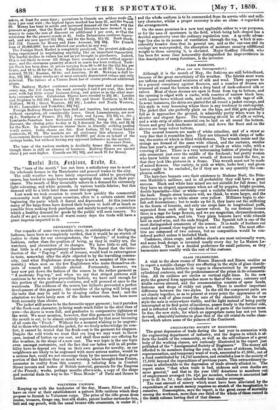PARIS FASHIONS.
(Prow our own Correspondent.)
Although it is the month of May, the fashions are still behindhand, because of the great uncertainty of the weather. The fabries most worn are taffetas and embossed mixtures of silk and wool. There appears to be a general conspiracy against flounces, and a number of dresses are trimmed all round the bottom with a deep band of dark-coloured silk or velvet. Most of these dresses are open in front from top to bottom, and the opening is edged with a niche, with rosettes of narrow black lace, with square bows without ends, and steel buckles, or with tags of silk. In some instances, the skirts are plaited flat all round a jacket corsage, and this style is very becoming where there is any tendency to embonpoint. The jacket that site perfectly plain on the hips, and that gets gradually full as it approaches the ground, is admirably pretty when worn by a slender and elegant figure. The trimming should be of silk or velvet, and a wide strip of either material can be laid on all round the bottom. Green and grey look handsome mixed; and down the front and on the sleeves are large velvet buttons.
The newest bonnets are made of white crinoline, and of a straw so very fine that it resembles lace. They are trimmed with clasps of taffe• tee, the centre of which is filled with flowers. The wreath inside and the strings are formed of the same wide riband, and the curtains, smaller than last year's, are generally composed of black or white tulle, with a covering of lace. There is a very unbecoming fashion of placing the in- side ornament just over the middle of the forehead; but pretty women who know better wear an entire wreath of flowers round the face, so that they look like pictures in a frame. This wreath must not be made of mixed flowers. One variety, in pink or white, looks best ; and green leaves ought to be excluded, for if they are in any quantity the com- plexion suffers. The hair-lace bonnets owe their existence to Madame Noel, the Prin- cess Mathilde's milliner, and in all probability they will have a great success. Black and white hair mixed are not suitable for full dress ; but they have an elegant appearance when set off by poppies, bright peonies, double hyacinths—lilac or white—and a voilette thrown carelessly over the back. Simple straw bonnets will, we think, be worn larger, and the preference is given to white straw over yellow. Milliners begin to abo- lish soft foundations ; but to make up for it, they leave out the stiffening in the fronts of bonnets, and only use crepe lisse in longitudinal puffs, separated from each other by narrow velvet. In our firstrate houses there is a rage for large flowers, and we see magnolias, chrysanthemums, poppies, china-asters, and iris. Very plain bonnets have wide ribands laid on scarf-wise, and the ends fringed. The Spanish tuft is one of the most distinguished ornaments of the season. It is made of feathers cut round and pressed close together into a sort of rosette. The most effec- tive are composed of two colours, but no composition would be con- sidered perfect unless it included black.
Cashmere, china crape, and taffetas shawls are most universally worn, and some fresh design is invented nearly every day by La Maison Le- clarc-Colot. There is a decided preference for small patterns, as they harmonize more readily with the rest of the costume.


























 Previous page
Previous page